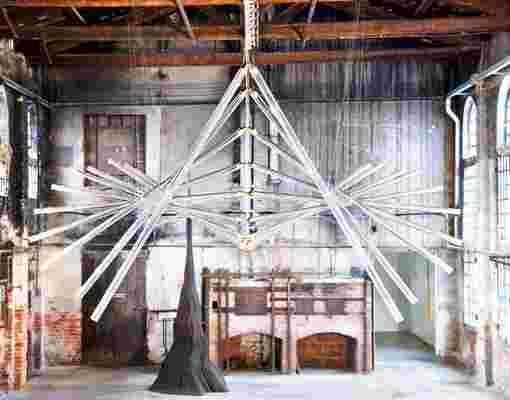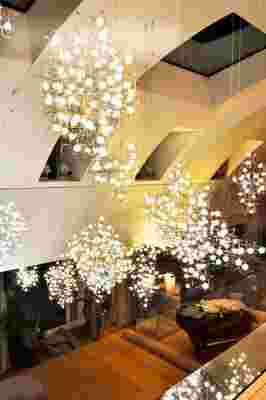Amsterdam Design Firm Studio Drift's Light Installations Fuse Nature and Technology
Punctuating the courtyard of London’s CitizenM hotel, 14 newly installed light fixtures rise and fall in rhythm, each one swathed in water-resistant fabric and suspended by a motorized steel cable. Midair, the sail-like pendants balloon out, catching the wind in their bellies and occasionally whipping back and forth, like a troupe of renegade petticoats. Guests can’t help but stop and stare.
Hypnotic and magical, the project marks the first outdoor installation by Studio Drift, the Amsterdam design firm founded by Ralph Nauta and Lonneke Gordijn in 2006. “We had to think about the rain, the cold, the docking station that would power the lights overnight,” says Nauta, adding that the courtyard fixtures expand upon the duo’s Shylight series, examples of which can be found at the Dutch city’s Rijksmuseum.

Made up of undulating glass rods, the project In 20 Steps was displayed in an abandoned factory during Venice’s 2015 art biennial.
To boldly embrace the elements seems appropriate for the designers, who have been exploring the intersection of nature and technology since meeting as students at the Design Academy Eindhoven. Their breakthrough moment arrived a decade ago, thanks to a humble weed. After plucking a dandelion from her garden, Gordijn—enchanted by the plant’s ethereal form—glued its wispy halo of seeds to an LED light on a copper stem, powering the fixture with a household nine-volt battery. The piece was the first iteration of Studio Drift’s seminal Fragile Future series, which would evolve to include elaborate networks combining dozens of dandelion heads and bronze circuitry.
Each spring Gordijn and Nauta still venture out into fields with members of their 14-person studio for an annual dandelion harvest, collecting seeds for private commissions, which, over time, have grown more and more elaborate. One Fragile Future fixture might span an entire wall; another may crawl through a doorway. “The possibilities are endless,” Gordijn says.

A private commission from the firm’s Fragile Future series features cloudlike clusters of dandelion seeds and circuitry.
All the while, Studio Drift is finding new ways to mix organic forms and modern technology in kinetic, seemingly gravity-defying installations. At Venice’s 2015 art biennial, for instance, the firm fashioned a group of glass rods into a skeletal mechanized sculpture that undulated in midair like a living organism. For the ongoing Flylight series, swarms of glass tubes hanging from the ceiling illuminate at random, mimicking the unpredictable flight patterns of birds. “People always want to leave earth and start doing the impossible,” notes Gordijn. “I think it’s in the genes—at least it’s in our genes.”
Now the designers are preparing for an upcoming solo show at New York’s Pace Gallery, their first with the international arts powerhouse. The exhibition’s hush-hush pièce de résistance required them to all but empty their work space to make room for it. Unyielding in her oath of silence, Gordijn playfully reveals, “It’s super–high-tech, it’s supernew, it’s superweird, and it’s made of concrete.”
Adds Nauta, “You’ll enter a space and not believe what you see. Maybe a piece looks too fine or too delicate. It’s interesting to test the limits.” studiodrifom
Related: See More AD Innovators